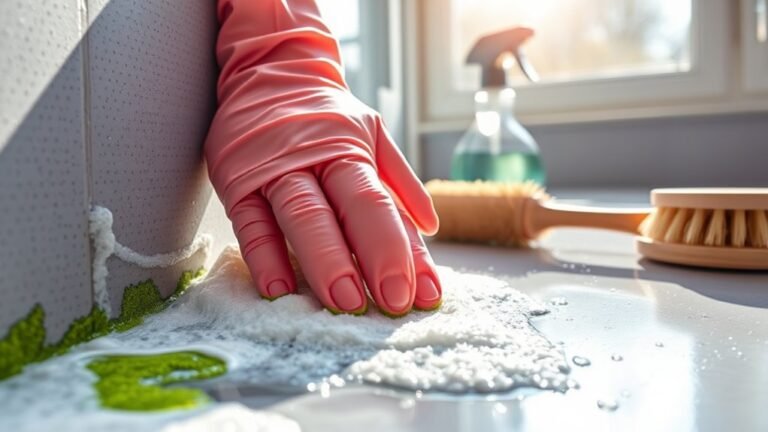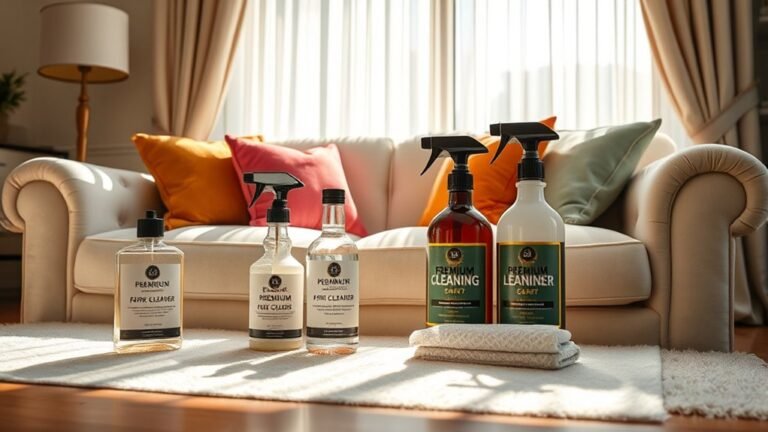Washing Mirror Without Damage
You can wash your mirror without damage by using gentle, eco-friendly cleaners like a mixture of equal parts water and white vinegar. Always use soft, lint-free microfiber cloths to avoid scratches and never apply cleaner directly on the mirror—spray it on the cloth instead. Gently wipe away dust and stubborn marks without harsh scrubbing to keep your mirror shiny and streak-free. If you want to keep your mirror looking flawless longer, there’s more helpful advice to explore.
Choosing the Right Cleaning Solutions

Before you start cleaning your mirror, it’s important to pick the right solution to avoid damage. You want something effective yet gentle, so harsh chemicals are out of the question. Eco friendly cleaners are your best bet—they clean well without risking scratches or residue. Vinegar solutions, made by mixing equal parts water and white vinegar, work wonders and are completely natural. They cut through grime and streaks without leaving harmful residues. Plus, using these options means you’re freeing yourself from toxic fumes, keeping your space healthy and fresh. Choosing the right cleaner isn’t just about the mirror—it’s about embracing a lifestyle that values simplicity, safety, and sustainability. With the right solution in hand, you’re set to make your mirror shine effortlessly.
Preparing Your Cleaning Tools
Gathering the right tools is key to cleaning your mirror effectively and safely. Start by selecting soft, lint-free cleaning cloths that won’t scratch the surface. Microfiber cloths are a perfect choice because they trap dirt without harsh abrasion. Next, put on protective gloves to shield your hands from any cleaning solutions, especially if you’re using something stronger than water. Gloves also help you maintain a firm grip on your tools, giving you control and freedom to clean confidently. Avoid abrasive sponges or paper towels, as they can leave scratches or fibers behind. By preparing your cleaning cloths and protective gloves ahead of time, you set yourself up for a smooth, damage-free mirror cleaning experience that lets you enjoy a sparkling reflection without worry.
Removing Dust and Loose Dirt

Before you start washing, it’s important to gently remove dust and loose dirt to avoid scratches. You’ll want to use soft tools like microfiber cloths or feather dusters for this step. Regular dusting helps keep your mirror looking clear and makes deep cleaning easier.
Gentle Dusting Techniques
Dust can settle quickly on mirrors, dulling their shine if not handled carefully. To keep your mirror spotless without damage, you’ll want to use gentle dusting techniques. Feather duster techniques are perfect for lifting dust without scratching the surface. Microfiber cloths are also your best friends—they trap dust instead of just moving it around. Here’s how to do it right:
- Use a soft feather duster to gently sweep away loose dust.
- Lightly wave the duster across the mirror instead of pressing hard.
- Employ a clean, dry microfiber cloth to capture remaining dust.
- Work in circular motions for even coverage.
- Avoid harsh wiping, which can cause micro-scratches.
Tools for Dust Removal
Keeping your mirror free of dust starts with having the right tools at hand. You’ll want to use microfiber cloths because they’re gentle yet effective at trapping dust without scratching the surface. These cloths give you freedom to clean thoroughly without worrying about damage. For those hard-to-reach corners or delicate edges, soft bristle brushes are your best friends. They sweep away loose dirt without leaving residue or causing abrasion. Avoid harsh materials that can damage the mirror’s finish. By choosing microfiber cloths and soft bristle brushes, you maintain your mirror’s clarity effortlessly, empowering you to keep it spotless while protecting its surface. With these tools, dust removal becomes a quick and damage-free routine that fits your lifestyle perfectly.
Frequency of Dust Cleaning
Regularly wiping your mirror helps prevent the buildup of dust and loose dirt that can dull its shine. To keep your mirror looking fresh without risking damage, consider these frequency recommendations based on dust accumulation:
- Clean high-traffic or humid areas weekly to avoid stubborn dust layers.
- For less-used spaces, biweekly dusting often suffices.
- If you notice visible dust settling quickly, increase cleaning frequency.
- Use gentle dust removal tools to avoid scratches during frequent cleaning.
- Stick to a routine that fits your lifestyle, promoting effortless upkeep.
Techniques for Spot Cleaning Stubborn Marks

Tackling stubborn marks on your mirror calls for targeted spot cleaning techniques that won’t damage the surface. When you see those persistent spots, grab a soft microfiber cloth dampened with a gentle glass cleaner or a mix of water and white vinegar. Dab the cloth gently on the stubborn marks—don’t rub hard, as that might scratch the mirror. For really tough spots, try a cotton swab dipped in the solution to precisely target the area without spreading residue. Always avoid abrasive materials or harsh chemicals that could harm the reflective coating. By focusing on spot cleaning, you keep your mirror clear and pristine without risking damage, giving you the freedom to enjoy a flawless reflection every day.
How to Avoid Streaks on Mirrors
Once you’ve carefully spot-cleaned stubborn marks, the next step is making sure your entire mirror stays streak-free. Streak prevention is all about technique and the right tools. To keep your mirror shining without damage, try these tips for effective mirror polishing:
- Use a microfiber cloth instead of paper towels to avoid lint and streaks.
- Spray your cleaning solution onto the cloth, not directly on the mirror, to prevent drips.
- Wipe in a circular motion to evenly polish the surface.
- Avoid cleaning mirrors in direct sunlight, which can cause faster drying and streaks.
- Finish with a dry, clean microfiber cloth to buff away any remaining moisture.
With these simple steps, you’ll enjoy a clear, streak-free reflection that feels freeing and flawless.
Cleaning Frames Without Causing Damage
Although cleaning the mirror itself is important, you shouldn’t overlook the frame, as it can collect dust and grime that dull its appearance. When cleaning frames, first identify the frame materials—wood, metal, or plastic—to choose the right approach. For wooden frames, avoid harsh chemicals that can damage frame finishes; instead, use a soft cloth dampened with mild soap and water. Metal frames may tolerate gentle polishing, but be cautious not to scratch or strip protective coatings. Plastic frames often handle light cleaning well but avoid abrasive scrubbing. Always test your cleaning method on a small, hidden spot to protect the finish. By respecting frame materials and finishes, you keep your mirror looking fresh without risking damage or loss of its unique character.
Handling Large Mirrors Safely
When handling large mirrors, you’ll want to use proper lifting techniques to avoid injury and prevent damage. Make sure you have a secure grip and lift with your legs, not your back. Once lifted, place the mirror on a stable, padded surface to keep it safe while you clean.
Proper Lifting Techniques
Handling large mirrors safely starts with knowing how to lift them properly. You want to protect both the mirror and yourself, so mastering proper posture and using the right lifting equipment is key. Here’s how you can lift confidently without risking damage or injury:
- Stand close to the mirror to keep control.
- Bend your knees, not your back, maintaining proper posture.
- Use lifting straps or gloves for a secure grip.
- Lift slowly and steadily, avoiding sudden movements.
- If the mirror is too heavy, don’t hesitate to ask for help.
Secure Placement Tips
Once you’ve lifted the mirror safely, you’ll want to confirm it’s placed securely to prevent accidents or damage. Start by choosing a sturdy wall free of moisture or hazards. Use secure mounting hardware designed for your mirror’s weight and size—anchors and brackets are a must. Double-check the mirror placement by measuring height and alignment before drilling. If possible, enlist help to hold the mirror steady while you fasten it. Avoid placing mirrors where they might easily tip or fall, such as near doorways or unstable surfaces. Remember, secure mounting isn’t just about safety; it preserves your mirror’s clarity and longevity. Taking these careful steps guarantees your freedom to enjoy a clean, beautiful reflection without worry.
Preventing Damage to Mirror Coatings
Although mirrors may look sturdy, their coatings are surprisingly delicate and can be easily damaged if you’re not careful. To guarantee your mirror’s coating protection lasts, adopt mindful mirror maintenance habits. You want to keep that freedom of use without worry, right? Here’s how to prevent damage:
- Use a soft, lint-free cloth to avoid scratches
- Avoid harsh chemicals; opt for gentle, pH-neutral cleaners
- Don’t apply pressure; let the cloth do the work
- Dry the mirror thoroughly to prevent moisture damage
- Clean regularly but sparingly to maintain the coating’s integrity
Maintaining Mirror Shine Between Cleanings
Keeping your mirror’s shine between deep cleanings doesn’t have to be a challenge. You can easily maintain its brilliance by wiping it down with a soft, dry microfiber cloth daily. This simple habit helps in preventing watermarks and dust buildup, which dull the surface over time. If you notice any spots, lightly mist the mirror with a mixture of water and vinegar, then gently wipe to avoid streaks. Avoid harsh chemicals that might damage coatings, ensuring your mirror stays pristine longer. By consistently caring for it this way, you’re not only preventing watermarks but also enhancing reflective quality, letting your mirror shine bright and clear. This approach gives you the freedom to enjoy a spotless mirror without the hassle of constant deep cleaning.
Frequently Asked Questions
Can I Use Vinegar on Antique Mirrors?
You might want to avoid using vinegar on your antique mirrors since it can damage the delicate backing and finish. When it comes to antique mirror care, it’s better to choose gentler vinegar alternatives like distilled water mixed with a tiny bit of mild dish soap. This way, you get to keep your mirror’s vintage charm intact without risking harm. You deserve the freedom to enjoy your treasures safely and beautifully.
How Often Should Mirrors Be Deep Cleaned?
When it comes to mirror maintenance, how often you deep clean really depends on your environment and personal preference. Generally, doing a thorough cleaning every few months keeps mirrors sparkling without overdoing it. If you live in a humid or dusty area, you might want to increase that cleaning frequency. Remember, regular light cleaning combined with occasional deep cleans gives you the freedom to enjoy clear reflections without stress or damage.
Are Paper Towels Safe for Mirror Cleaning?
You might wonder if paper towels are safe for mirror cleaning. While they’re convenient, they can leave lint or even scratch delicate surfaces. Instead, consider paper towel alternatives like microfiber cloths or soft cotton rags—they’re gentler and more effective. By exploring different mirror cleaning techniques, you’ll enjoy streak-free results without damage. So, feel free to ditch paper towels and embrace methods that give you cleaner mirrors with less hassle.
What Should I Do if My Mirror Cracks During Cleaning?
If your mirror cracks during cleaning, don’t panic like a Victorian stuck without a telegram. First, stop using any cleaning techniques that might worsen the damage. You’ll want to carefully assess the crack—if it’s minor, mirror repair kits can help you fix it yourself. But if it’s severe, freedom means choosing to replace it without hassle. Always prioritize safety; shards can be sharp, so handle with care and consider professional help.
Can Humidity Affect Mirror Cleanliness or Damage?
Yes, humidity effects can definitely impact your mirror’s cleanliness and even cause damage over time. When moisture lingers, it can lead to fogging, streaks, or even mold around the edges. To keep your mirror clear and safe, you’ll want to adjust your cleaning techniques—use a soft, dry cloth after cleaning to wipe away any leftover moisture. This way, you’ll enjoy a crystal-clear reflection without worrying about humidity messing things up.






